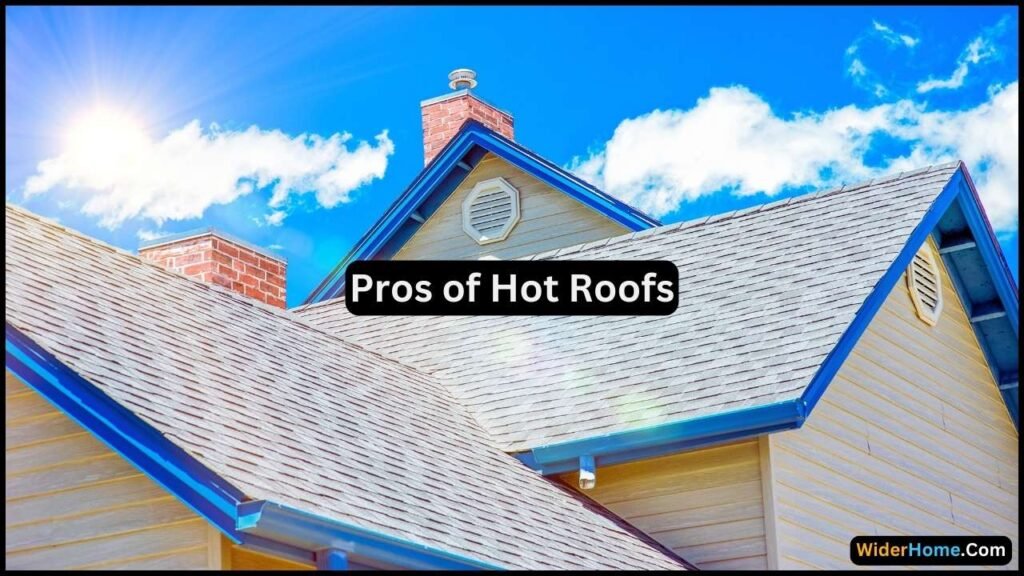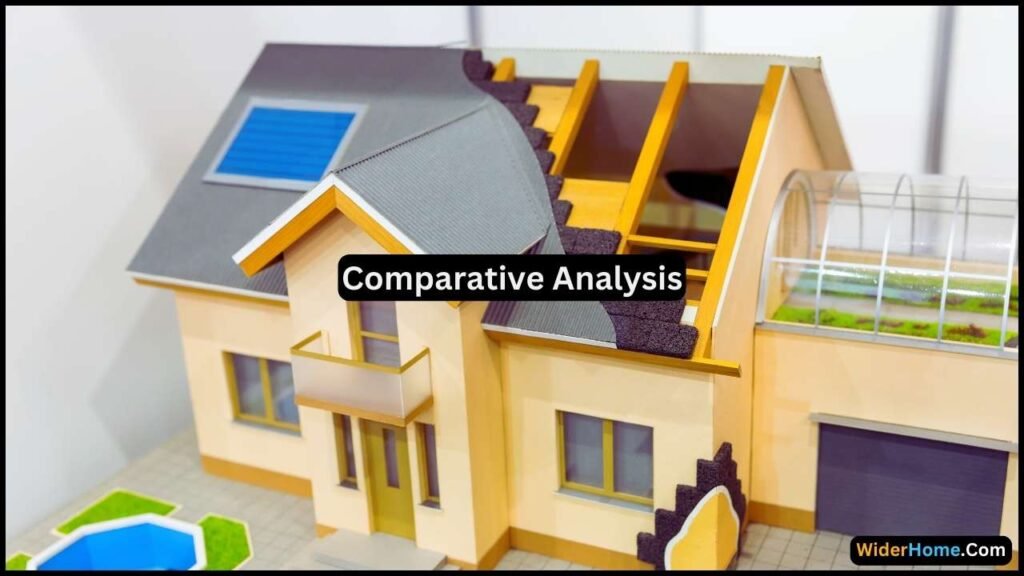Is a Hot Roof a Good Idea?

A hot roof is a roofing system where the insulation is placed on the exterior side of the roof deck, allowing the roof structure to become part of the conditioned space.
This design contrasts with traditional roofs with insulation in the attic, often leading to unconditioned, colder spaces. The purpose of this outline is to comprehensively evaluate the benefits and drawbacks of hot roofs.
By understanding both the advantages—such as increased energy efficiency and potential longevity—and the disadvantages—like risks of overheating and moisture issues—homeowners can make informed decisions about whether a hot roof is suitable for their specific needs and circumstances.
Understanding Hot Roofs
A hot roof works by placing insulation outside the roof deck. This means the roof itself helps keep the inside of the building warm or cool, depending on the season.
Unlike traditional roofs, where the insulation sits in the attic and makes that space chilly, hot roofs keep everything cozy by preventing heat from escaping.
Most hot roofs use materials like rigid foam insulation boards or spray foam. These materials create a tight seal, which helps stop air from leaking in or out.
This method is beneficial when temperatures change significantly, as it helps maintain a comfortable living environment.
As people pay more attention to energy-saving methods and sustainable building practices, hot roofs are becoming popular for new constructions. Understanding how hot roofs work is crucial for deciding whether they fit your home well.
Pros of Hot Roofs

Hot roofs offer several compelling advantages that can enhance a home’s comfort and efficiency.
Energy Efficiency
One of the primary benefits of hot roofs is their improved energy efficiency. By placing insulation outside the roof deck, hot roofs create a more consistent thermal barrier, effectively reducing heat loss during winter months and heat gain in the summer.
This results in lower energy costs for heating and cooling, as the conditioned air remains within the living spaces, leading to greater comfort year-round.
Longevity and Maintenance
Hot roofs can contribute to a longer lifespan for roofing systems. Since the insulation protects the roof structure from temperature extremes, there is less stress on roofing materials, potentially reducing the frequency of repairs and replacements.
Additionally, hot roofs typically require less maintenance than traditional ones, as the design minimizes the risk of leaks and water damage.
Environmental Considerations
From an environmental standpoint, hot roofs help decrease a building’s carbon footprint. The overall impact on the environment is reduced by improving energy efficiency and often utilizing sustainable materials, such as recycled or eco-friendly insulation.
This is particularly important as homeowners increasingly seek green building practices and materials aligning with their sustainability goals.
Cons of Hot Roofs

While hot roofs offer numerous benefits, there are also significant drawbacks that homeowners should consider before opting for this roofing system.
Risk of Overheating
One of the primary concerns with hot roofs is the potential for overheating. Since the roof structure is part of the conditioned space, high outdoor temperatures can lead to elevated indoor temperatures, making living spaces uncomfortable. This risk is especially pronounced in regions with hot climates.
Impact on Indoor Temperatures
Hot roofs can exacerbate indoor heat, requiring increased air conditioning efforts and higher energy costs if not correctly designed or ventilated.
Potential for Heat-Related Damage
Excessive heat can also contribute to the degradation of roofing materials over time, potentially leading to premature failures and necessitating more frequent repairs or replacements.
Moisture and Condensation Issues
Hot roofs can present challenges related to moisture control and ventilation. The warm air within the roof assembly can create conditions conducive to condensation.
Risk of Mold Growth
Condensation can lead to excess moisture within the structure, increasing the likelihood of mold growth and compromising indoor air quality.
Challenges in Maintaining Ventilation
Ensuring proper ventilation in a hot roof system can be complex. If ventilation is inadequate, moisture can accumulate, leading to structural harm and additional repair costs.
Cost Implications
The initial costs associated with installing a hot roof are typically higher than those for traditional roofing systems due to the required specialized materials and construction techniques.
Higher Initial Installation Costs
Homeowners may face a significant financial investment upfront, which might be a deterrent for some seeking budget-friendly options.
Potential for Increased Repair Costs if Issues Arise
Repair costs can escalate if problems emerge, such as overheating or moisture infiltration, primarily if the underlying causes are not promptly addressed. This can lead to a longer-term financial burden for homeowners who opt for this roofing solution.
Comparative Analysis of Hot Roof

When comparing hot roofs to traditional roofs, key areas to consider include energy efficiency, insulation, installation costs, and maintenance.
Energy Efficiency Comparison
Hot roofs are better at keeping a building’s temperature stable because they have insulation that prevents heat from getting in or out.
Traditional roofs with insulation in the attic can lose or gain heat more efficiently, requiring more energy.
Insulation Performance
Hot roofs usually outperform traditional roofs in terms of insulation. They use materials like rigid foam that create a strong seal against any air leaks. In contrast, traditional insulation may leave small gaps, making it less effective.
Installation and Cost Implications
While installing a hot roof may cost more due to the unique materials and skills needed, it can save money on energy bills and maintenance in the long run.
Traditional roofs are cheaper to install but could cost more later for repairs and higher energy bills.
Longevity and Maintenance Considerations
Hot roofs generally last longer and need less maintenance than traditional roofs, which often require more regular check-ups and repairs for things like leaks.
Homeowners should consider these long-term benefits when deciding which type of roof is best for them.
FAQs
What is a hot roof?
A hot roof is a roofing system where insulation is installed directly under the roof deck, resulting in a roof that retains heat, typically found in buildings without ventilated attic space.
What are the benefits of a hot roof?
Hot roofs can improve energy efficiency by reducing heat loss in colder months. They can also minimize the risk of ice dams, allow for increased attic space, and simplify construction methods.
Are there any drawbacks to a hot roof?
Yes, potential drawbacks include the risk of overheating during warmer months, which may increase cooling costs. Proper installation and ventilation are also crucial to prevent moisture buildup and associated damage.
What’s the difference between a hot roof and a cold roof?
A cold roof features ventilation between the insulation and the roof deck, helping to maintain cooler temperatures. In contrast, a hot roof retains heat, which can be beneficial in certain climates but potentially problematic in others.
Is a hot roof suitable for all climates?
While hot roofs can be advantageous in colder climates, they may not be ideal in hotter areas without adequate ventilation. Before deciding, it’s essential to consider local climate conditions and consult with a roofing professional.
How long will a hot roof last?
Depending on installation techniques, upkeep, and material quality, a hot roof can last 20 to 50 years. The roof’s lifespan can be extended, and possible problems can be addressed early on with routine inspections and maintenance.
How do you ventilate a hot roof?
Air circulation must be sufficient to prevent moisture development and efficiently ventilate a hot roof. Installing vents at the roof’s eaves and ridge will achieve this by letting warm air escape and cool air enter.
To improve airflow and lower the risk of overheating, exhaust fans and a careful balance between insulation and ventilation should be used. Conducting routine inspections to look for obstructions in ventilation routes is also essential.
Conclusion
To sum up, there are several elements to carefully consider when deciding between hot roofs and regular roofing systems. Hot roofs are more energy-efficient, provide better insulation, and require less maintenance during their longer lifespans. Even though the initial installation costs could be more significant, they might be a wise investment in the long run due to the savings on energy bills and the decreased need for repairs. However, the initial costs of traditional roofing could be lower. However, over time, they might result in increased costs because of upkeep and inefficiencies. To choose the ideal roofing scenario, homeowners should consider their needs, finances, and long-term objectives.
Image credits: Canva
